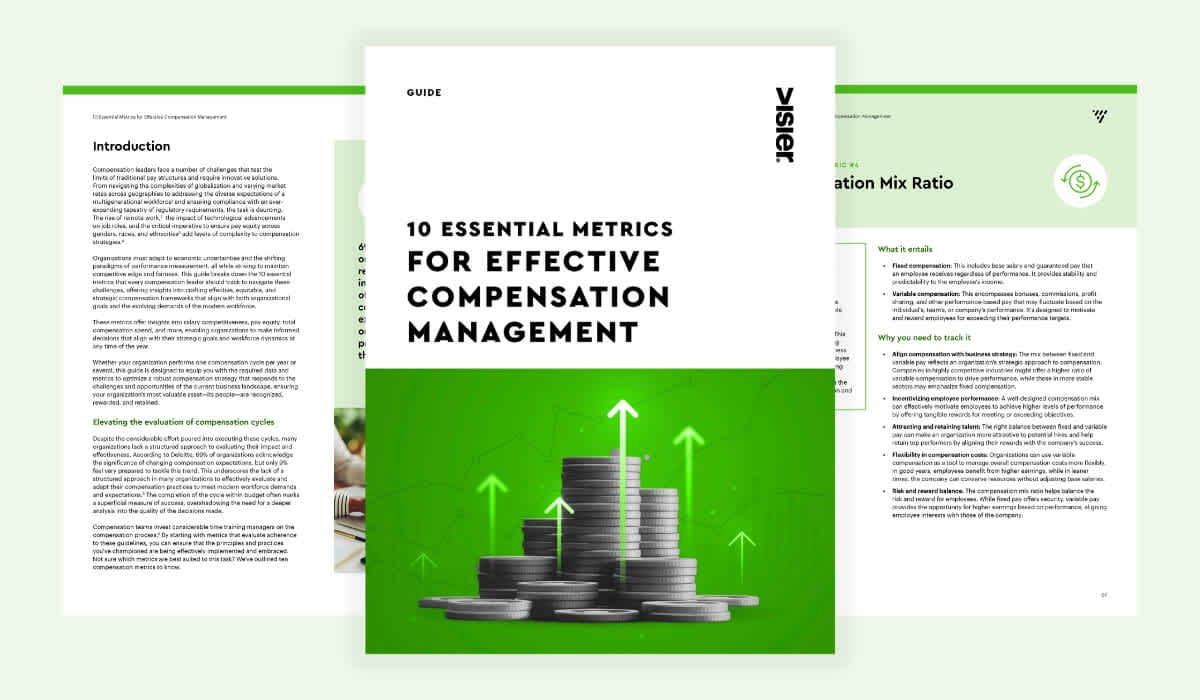How to Get Started with Salary Benchmarking
Salary benchmarking is a process of matching job descriptions and salary ranges to similar jobs in the industry. Learn more.

Salary is a key component of a company’s success. Well-paid employees perform better, and they’re less likely to leave. Plus, an attractive compensation package will help you hire top talent. Salary benchmarking is a process that helps you control expenses and offer competitive salaries.
Benchmarking requires careful data analysis and a good compensation strategy. With it, you can be sure you’re meeting the market and offering pay that makes employees feel valued. Here’s how you can get started with salary benchmarking.
What is salary benchmarking?
Salary benchmarking, also known as compensation benchmarking, is a process of matching job descriptions and pay ranges to those from similar jobs in other organizations. It helps you see the average salary for a certain job. This ensures that you are meeting that benchmark, which in turn helps you attract and retain top talent.
Compensation benchmarking isn’t only about looking at payment data. In your analysis, you need to look at other factors as well.
These include:
The size of the company
The location
The industry
The education level needed for a certain position.
After gathering the data, the next step is running a comparison with the internal salary database. Look for places where you’re meeting the market, where you’re above it, or below. Adjusting the salary ranges to be in line with the market will ensure you remain competitive.
Don’t forget that, often, the salary is not the only component of the compensation plan. This might include other bonuses and benefits, such as retirement plans, health insurance, and more. Salary benchmarking is the key element, but don’t limit yourself to the paycheck alone.

Why is salary benchmarking important?
Salary benchmarking is an important tool in any talent management process. By being aware of the market ranges for various positions, you can offer fair pay to your employees and remain competitive in your niche. You can also get a handle on compensation expectations and industry standards for different roles and different market segments. By doing so, you’re able to take the guesswork out of the negotiation process and offer an attractive compensation package.
If the salary you offer is too low, top talent will refuse to come on board. Plus, you might lose employees who will want to leave as soon as they find a company that pays more.
Salary benchmarking also helps you make sure you don’t end up at the opposite end of the spectrum—offering compensation way above average. Depending on your company, such a situation might sooner or later cause problems in your budget. If that happens, you could be forced to make adjustments to people’s salaries, which will come with dissatisfaction and even attrition.
Finally, compensation benchmarking helps you understand what expectations people have regarding their pay. You can create a profitable strategic compensation plan that benefits both you and the people in the company.
How to do salary benchmarking
Salary benchmarking is not a complicated process. It requires a few easy steps such as:
Choosing your data sources and creating a salary database;
Analyzing the competition;
Creating a compensation strategy;
Defining the salary ranges.
Let’s take a closer look at each of these steps.
Create a salary database
Benchmarking begins with choosing your data sources to create a salary database.
Start by listing all the positions you have in your company and their corresponding salary ranges. Don’t forget to include fringe benefits like bonuses, retirement plans, healthcare insurance, and more.
You’ll also need to include the job description for each role, along with its requirements, such as level of studies or experience.
To gather data, you have two major options—free surveys and aggregated data from paid sources. Free surveys don’t always have accurate or up-to-date information, so use them carefully.
For companies operating in the United States, the U.S. Bureau of Labor Statistics is a valuable free resource. SHRM’s Compensation Data Center is another good starting point for companies willing to pay for compensation benchmarking data.
Analyze the data
Once you have both your own data and the average market ranges, you can move on to the next step. Compensation alone won’t give you an accurate view of your competition.
When analyzing and comparing salaries, look at other factors as well. The best place to start is the job description.
For instance, one company may pay more for a position that looks similar at first sight. But when you analyze it closely, you might find that the job includes many more tasks. They might be requesting a higher level of education or experience. Here, a lower wage could be justified.
Create the compensation strategy
A compensation strategy is key when trying to align the remuneration with the company’s goals. For instance, are you trying to hire the very best? In that case, your compensation strategy should include higher salary ranges and benefits.
Define the salary ranges
Finally, you can set the salary ranges. These will help you be more transparent with candidates and employees and can reduce inequities.
Having clear pay ranges for each position is useful when planning the budget. You know the number of employees you have, how many more people you plan on hiring, and the maximum (and minimum) amount you’ll be paying them.
If salary transparency is part of your compensation strategy, then you’ll also want to find ways to communicate these ranges to employees. This could be in the form of 1:1 conversations between supervisors and employees or published in a central location by department.
Regardless of how you share salary range information, make sure it toes the line between being transparent, and secure enough to prevent leaks to the competition.
Elements of salary benchmarking
Strategic compensation, surveys, and job matching are the three main elements of salary benchmarking. With them, you can gather the correct data, and establish fair, transparent, and competitive salary ranges.
1. Strategic compensation
If you want equity, transparency, and competitiveness when it comes to salaries, strategic compensation is a must. For that, you need to:
Assess your goals—both financial and in terms of the overall results;
Analyze the current salary ranges;
Conduct market studies;
Establish a budget;
Ensure compliance with local compensation laws;
Create a plan that includes more than just a paycheck;
Communicate your strategy with people in the company.
All this will be useful when comparing your salary database with the data gathered from external sources. It will also be the foundation when you’re working on setting the final salary ranges.
2. Surveys
Salary benchmarking surveys provide a strong foundation when trying to understand the market.
For the data to be as accurate as possible, these surveys should take into account things like:
Industry;
Company size;
Location.
Remember that free surveys can often contain incorrect data. That’s why many prefer to use paid surveys collected by specialized companies or aggregated market research data.
3. Job evaluation and matching
The final element of salary benchmarking is evaluating and matching job descriptions. If you want to eliminate inequities and ensure transparency, this is a crucial part of the benchmarking process.
Job matching looks at the importance of a job, the seniority, the level of education required, and more. There are usually four ways to evaluate a job: ranking, factor comparison, point factor, and grading.
Ranking is the simplest of the four methods. It is perfect for small to medium-sized businesses (SMBs). It evaluates jobs based on one factor such as the difficulty or the level of education required. This method is not great for larger companies, where it is harder to rely on a single factor to define salary ranges.
The point-factor is a comparison method that looks at different factors identified while analyzing job descriptions and requirements. To use this method, you need to assign different points for different skills, requirements, and other attributes. In the end, you’ll also be looking at the difficulty of a certain job. But unlike with the previous method, you’re taking more than a single factor into consideration.
Factor comparison is similar to the point-factor method, but also takes into account the ranking of a position. It is more complicated, and not ideal for SMBs. However, because of the large variety of factors included in the evaluation process, it is considered the least subjective method.
Job grading, also called job classification, is a method where each job description is assigned a grade based on its complexity and skills. Responsibilities, competencies, physical exertion, and even things like shift work, are taken into account. It is a fairly straightforward method of evaluating jobs. Some say it is not great for complex or hybrid roles. But most agree it works well with simple jobs.
Key takeaways
Salary benchmarking matches job descriptions and salary ranges to similar jobs in the industry. It is a great way to ensure transparency, and equity, and to stay profitable and competitive.
The benchmarking process requires a few easy steps:
Creating a salary database where you look at all the jobs in your organization and the remuneration for each;
Collecting data from various sources such as surveys and aggregated market research;
Analyzing and comparing data;
Creating a strategic compensation strategy;
Setting the salary ranges.



